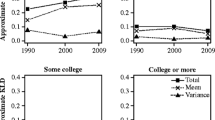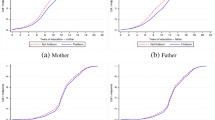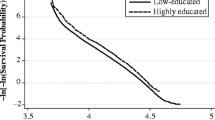Abstract
The contrasting results from previous research motivate this reexamination of the longevity-schooling relationship. The study uses a different identification strategy applied to cohort-specific data from 919 household surveys conducted between 1960 and 2012 spanning 147 countries. We find a significant positive relationship between increased life expectancy at birth and lifetime completed years of schooling in 95% of the surveys and significant negative effects only in 0.3%. In addition, parents’ own longer life expectancy at birth has intergenerational benefits for their children’s schooling. The 31-year increase in life expectancy at birth worldwide for birth cohorts 1922–1987 is associated with 60–100% of the 4.8 additional years of completed schooling for those birth cohorts. These results are robust for different specifications across surveys, population groups, and world regions.



Similar content being viewed by others
Notes
Heckman’s (1976) model generates solutions to lifetime human capital, labor supply and consumption as functions of the initial endowments.
We also experimented with life expectancy at birth 20 and 30 years prior as our measure of the parents’ health endowment. In practice, life expectancy at birth 20, 25, and 30 years prior were highly correlated.
Unexpectedly large cohorts will face depressed earnings from a crowding of more individuals into the market, particularly if different birth cohorts are not perfect substitutes in production. To the extent that the potential for crowding in is expected, individuals in cohorts with rising life expectancy will moderate their human capital investment decisions to reflect anticipated depreciated earnings per unit of human capital.
Miguel and Kremer (2004) conclude that deworming drugs raised completed schooling primarily by reducing student absence rates, and these benefits extended to the surrounding community because of the reduced transmission of infections. Unclear is how much of the increased schooling was due to the physiological effect of reducing helminthic infections and how much was due to the Ben-Porath effect.
This study provides a clearer test of the Ben-Porath hypothesis than those studies that have used weather conditions (Maccini and Yang 2009) or randomized nutrition programs (Maluccio et al. 2009) to measure changes in health status. For example, Maccini and Yang (2009) found that the amount of rainfall around the time of birth was linked to the health, education, and socioeconomic outcomes of Indonesian adults born between 1953 and 1974. The effect could be due to better nutrition and health from improved harvests, but it could be also due to better incomes from greater agricultural productivity.
We see this as a plausible reason for the Lorentzen et al. (2008) finding that adult mortality affects the schooling of younger cohorts.
The data generally do not show where an individual was born so we use the urban-rural residence during the survey instead, leading to some mismatch between birth-place and place of residence during the survey.
The UN maintains a rich database on various socio-economic indicators http://data.un.org/Default.aspx.
In the case where no estimates are available, they rely on simple model of interpolation and extrapolation to reach an approximate measure. Although Gap Minder admits that quality of life expectancy at birth data would vary across countries for the period before 1950, our extensive search suggests that this is the best available information covering such a wide set of countries for a long period before 1950.
Various region, gender, and age-specific life expectancy data is available at http://esa.un.org/wpp/Excel-Data/mortality.htm. The data are reported for 5-year birth cohorts rather than specific birth cohorts, and so we used the nearest age match.
For example, Germany has two surveys in our survey-pool, one in 2005 and the other in 2012. The youngest cohort in the former survey was born in 1980 while in the later survey the youngest was born in 1987. Since the cohorts who were born between 1980 and 1987 were under 25 during the survey of 2005, we only include these new cohorts from the second survey for Germany in our sample.
Not all regressions included the controls for urban/rural differences, either because only urban data was collected or because regional information was not collected.
While constructing the 5-year birth cohorts, we collapsed all individuals aged 25–65 into 13 different 5-year birth cohorts. Since the number of observations before 1930 is small, they are grouped into a cohort spanning more than 5 years. Similarly, all individuals, who were born during 1985–1987, were collapsed to form the last cohort spanning only 3 years.
The World Bank classifies the developing economies into six regions: “East Asia and Pacific,” “Eastern Europe and Central Asia,” “Latin America and Caribbean,” “Middle East and North Africa,” “South Asia,” and “Sub-Saharan Africa.” For the World Bank classification of countries, see http://data.worldbank.org/about/country-and-lending-groups.
The data and documentation is available at http://www.systemicpeace.org/inscrdata.html (accessed on October 8th, 2014). The polity scale varies from “strongly autocratic” coded as − 10 to “strongly democratic” coded as 10. We note that King et al. (2012) use alternative measures of economic and political institutions to determine if these institutions indeed alter returns to human capital sufficiently to explain part of the persistent cross-country income inequality. Democracy, for example, has been associated with the efficiency of government services, including education, health care, sanitation, and irrigation.
Belize, though included in our sample, does not have any polity data. In some cases, we could not use the available polity data since two countries have been consolidated into one, and the surveys do not identify respondents by the origin. For example, in surveys from Germany, we could not utilize cohorts born after 1945 since the surveys do not identify individuals born between 1946 and 1987 by place of birth, i.e., whether one was born in west or the eastern part. We exclude cohorts born before 1976 in Vietnam, and all cohorts born in Yemen for similar reason.
The original weather data (CRU TS 3.21) reports values for each month and each box on a 0.5° latitude/longitude grid. CRU assigned each box to a single country. For each country CRU calculated the weighted mean of the values from its constituent grid boxes for each month in turn. Each grid box was weighted by surface area, using the cosine of the latitude. The seasonal and annual values are the means of their constituent months. The CRU TS dataset prioritizes completeness and has no missing data over land. Where observations are unavailable, the 1961–1990 monthly climatic mean is used as a substitute. In data sparse regions of the world, this can lead to repeated values, and this can show up in derived products such as CRU CY.
In the above specifications, LEijc = LEjc + μij, which states that individual i’s life expectancy at birth in the country c deviates from cohort j’s mean life expectancy by μij, which is by construction orthogonal to mean. Since μij will be contained in the error term, the condition, Cov(εict, LEjc) = 0, must hold. Royalty (2000) has used state tax rate as an instrument for marginal tax rate in explaining employees’ health insurance eligibility. Similarly, a series of studies following Ruhm (2000) exploited variation in state or county level unemployment rate while explaining individual health behavior during a recession.
References
Acemoglu D, Johnson S (2007) Disease and development: the effect of life expectancy on economic growth. J Polit Econ 115(6):925–985
Barro R, Lee J-W (2013) A new data set of educational attainment in the world, 1950-2010. J Dev Econ 104:184–198
Becker GS (1994) Human capital: a theoretical and empirical analysis with special reference to education, 3rd edition. Chicago: University of Chicago Press
Becker GS, Tomes N (1979) An equilibrium theory of the distribution of income and intergenerational mobility. J Polit Econ 87(1979):1153–1189
Becker GS, Tomes N (1986) Human capital and the rise and fall of families. J Labor Econ 4(1986):S1–S39
Ben-Porath Y (1967) The production of human capital and the life cycle of earnings. J Polit Econ 75:352–365
Bleakley H (2007) Disease and development: evidence from hookworm eradication in the American South. Q J Econ 122(1):73–11
Bleakley H (2010a) Malaria eradication in the Americas: a retrospective analysis of childhood exposure. Am Econ J-Appl Econ 2(2):1–45
Bleakley H (2010b) Health, human capital, and development. Ann Rev Econom 2:283–310
Bleakley H (2017) Longevity, education, and income: how large is the triangle? Available at http://www-personal.umich.edu/~hoytb/Bleakley_Horizon_Triangle.pdf. Last accessed on 12 Aug 2017
Bobonis GJ, Miguel E, Puri-Sharma C (2006) Anemia and school participation. J Hum Resour 41(4):692–721
Cervellati M, Sunde U (2011) Life expectancy and economic growth: the role of the demographic transition. J Econ Growth 16(2):99–133
Cervellati M, Sunde U (2013) Life expectancy, schooling, and lifetime labor supply: theory and evidence revisited. Econometrica 81:2055–2086
Cohen D, Leker L (2014) Health and education: another look with the proper data. Available at http://www.parisschoolofeconomics.eu/docs/cohen-daniel/cohen-leker-health-and-education-2014.pdf. Last accessed on 17 July 2015
Cutler D, Fung W, Kremer M, Singhal M, Vogl T (2010) Early-life malaria exposure and adult outcomes: evidence from malaria eradication in India. Am Econ J-Appl 2(2):72–94
Dercon S, Sánchez A (2013) Height in mid childhood and psychosocial competencies in late childhood: Evidence from four developing countries. Econ Hum Biol 11(4):426–432
Glewwe P, Jacoby H, King E (2001) Early childhood nutrition and academic achievement: a longitudinal analysis. J Public Econ 81:345–368
Hansen CW (2013) Life expectancy and human capital: evidence from the international epidemiological transition. J Health Econ 32(6):1142–1152
Hansen CW, Strulik H (2017) Life expectancy and education: evidence from the cardiovascular revolution. J Econ Growth 22(4):421–450
Hazan M (2009) Longevity and lifetime labor supply: evidence and implications. Econometrica 77(6):1829–1863
Hazan M (2012) Life expectancy and schooling: new insights from cross-country data. J Popul Econ 25(4):1237–1248
Heckman JJ (1976) A life-cycle model of earnings, learning, and consumption. J Polit Econ 84:S9–S44
Jayachandran S, Lleras-Muney A (2009) Life expectancy and human capital investments: evidence from maternal mortality declines. Q J Econ 124(1):349–398
Kalemli-Ozcan S, Ryder HE, Weil DN (2000) Mortality decline, human capital investment, and economic growth. J Dev Econ 62(1):1–23
King EM, Montenegro CE, Orazem PF (2012) Economic freedom, human rights, and the returns to human capital: an evaluation of the Schultz hypothesis. Econ Dev Cult Chang 61(1):39–72
Kinsella K, Velkoff VA (2001) Life expectancy and changing mortality, Chapter 3, An aging world, 2001. International Population Reports, US Census Bureau, Series P95/01-1
Lorentzen P, McMillan J, Wacziarg R (2008) Death and development. J Econ Growth 13(1):81–124
Lucas AM (2010) Malaria eradication and educational attainment: evidence from Paraguay and Sri Lanka. Am Econ J-Appl Econ 2(2):46–71
Maccini S, Yang D (2009) Under the weather: Health, schooling, and economic consequences of early-life rainfall. Am Econ Rev 99(3):1006–1026
Maluccio JA, Hoddinott J, Behrman JR, Martorell R, Quisumbing AR, Stein AD (2009) The impact of improving nutrition during early childhood on education among Guatemalan adults. Econ J 119(537):734–763
Miguel E, Kremer M (2004) Worms: identifying impacts on education and health in the presence of treatment externalities. Econometrica 72(1):159–217
Oster E, Shoulson I, Dorsey ER (2013) Limited life expectancy, human capital and health investments. Am Econ Rev 103(5):1977–2002
Royalty AB (2000) Tax preferences for fringe benefits and the health insurance offered by employers. J Public Econ 75(2):209–227
Ruhm CJ (2000) Are recessions good for your health? Q J Econ 115(2):617–650
Shakotko R, Edwards L (2017) An exploration of the dynamic relationship between health and cognitive development in adolescence. In: Grossman M (ed) Determinants of health: an economic perspective. Columbia University Press, New York, pp 190–211
United Nations, Department of Economic and Social Affairs, Population Division (2017) World population prospects: the 2017 revision, DVD edition
World Health Organization (n.d.) Various years. World health statistics annual
Acknowledgements
The authors thank the referees and the editor for excellent comments and advice on our prior version.
Author information
Authors and Affiliations
Corresponding author
Additional information
Responsible editor: Junsen Zhang
Appendix
Appendix
1.1 Comparison with analysis using Barro-Lee (2013) data
To check the validity of our findings, we examine the empirical relationship between life expectancy at birth and completed years of schooling by birth cohort on alternative sets of countries and sources of data. For this, we use period estimates of life expectancy at birth from the Human Mortality Database (HMD) and combine these with completed schooling estimates from Barro and Lee (2013). Note that calculation of period estimate of life expectancy at birth exploits the age-specific mortality rate prevailing in that period while cohort life expectancy is based on actual mortality rate experienced by a particular cohort at different points in the lifecycle. The HMD reports period life expectancy at birth for 40 countries. However, only 15 of these countries have period life expectancy at birth data beginning from the first quarter of twentieth century. Since the cohort estimate of life expectancy requires observing the cohort for the lifetime, such data are available only for 10 countries covering at most up to 1925. To utilize maximum possible data, we focus on period life expectancy at birth data. We add information about these alternative databases in Appendix Table 12.
Barro and Lee (2013) compute country-specific years of schooling for 5-year age groups starting from age 15 from 1950. Based on the year of observation, each of the 5-year age groups can be mapped into a 5-year birth cohort. To be consistent with data used in our paper, since students below age 25 can still be in school, we discard age groups in the age range 15–25. In the Barro-Lee database, since we can observe each 5-year birth cohort multiple times in a country, we take their population weighted average. Further, as Barro-Lee provides school years by gender, we can construct a measure of the gender composition of each 5-year birth cohort.
Combining the HMD and Barro-Lee data, we get 32 countries with 360 5-year birth cohorts for the empirical exercise. We match the data with our original household survey, and this further matching gives us 246 5-year birth cohorts from 29 countries. A preliminary check on the merged data shows that the coefficient of correlation between Barro-Lee’s schooling data and our schooling data is 0.68 while that between HMD life expectancy and the Gap Minder data is 0.99. Such high correlation suggests the possibility of utilizing alternative sources for constructing the life expectancy at birth data.
We estimate our model using different combinations of the data (see tables below). All sets of results show the association between schooling and life expectancy at birth to be positive and statistically significant, but they differ somewhat in magnitude. To check whether the schooling data or the life expectancy data is driving the differences, we combine our schooling data (from the World Bank’s International Income Distribution Database) with life expectancy at birth data from HMD in one specification and the Barro-Lee schooling data with the Gap Minder life expectancy at birth data in another. The comparison of the life expectancy coefficients in specifications V and VI (0.16 vs. 0.22) suggests that the estimate is larger when using the Barro-Lee education measure.
Rights and permissions
About this article
Cite this article
Hoque, M.M., King, E.M., Montenegro, C.E. et al. Revisiting the relationship between longevity and lifetime education: global evidence from 919 surveys. J Popul Econ 32, 551–589 (2019). https://doi.org/10.1007/s00148-018-0717-9
Received:
Accepted:
Published:
Issue Date:
DOI: https://doi.org/10.1007/s00148-018-0717-9




